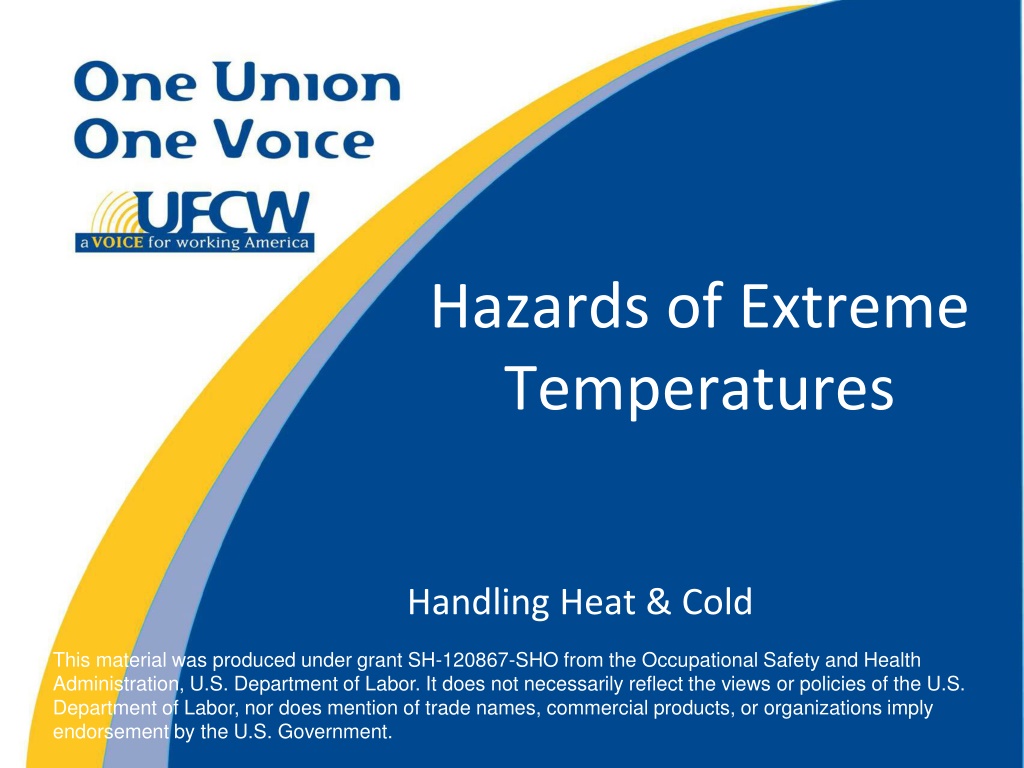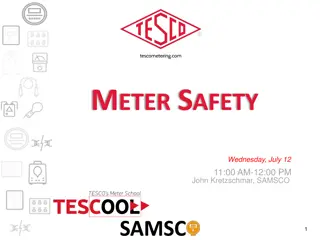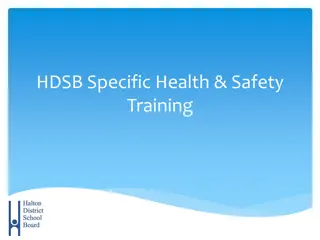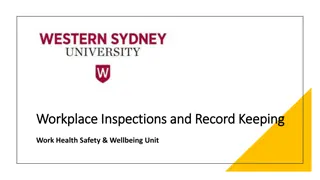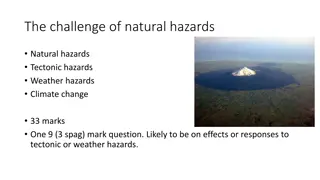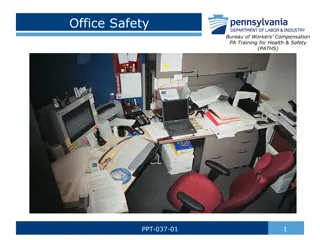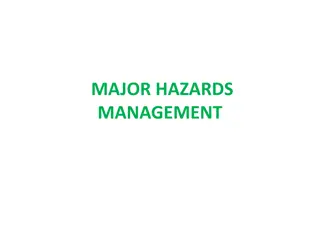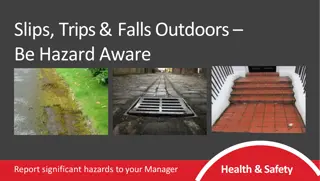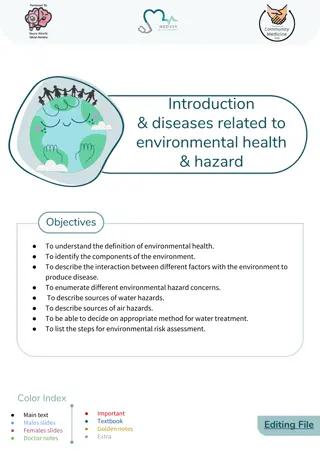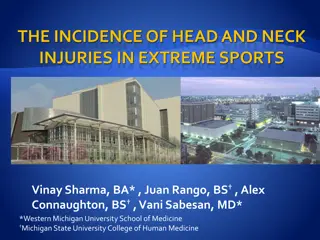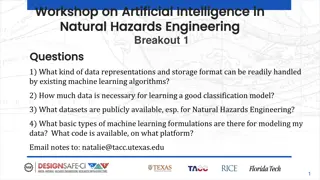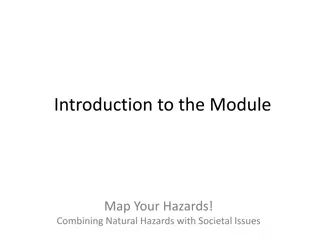Understanding the Hazards of Extreme Temperatures in the Workplace
Extreme temperatures, whether hot or cold, pose significant risks to worker health and safety. This material, developed by OSHA, highlights the dangers of heat and cold exposure, including heat stroke, hypothermia, and other related illnesses. The case study mentioned underscores the importance of proper heat evaluation and mitigation measures in preventing tragic incidents. Overall, being aware of the risks associated with extreme temperatures is crucial for maintaining a safe working environment.
Download Presentation

Please find below an Image/Link to download the presentation.
The content on the website is provided AS IS for your information and personal use only. It may not be sold, licensed, or shared on other websites without obtaining consent from the author. Download presentation by click this link. If you encounter any issues during the download, it is possible that the publisher has removed the file from their server.
E N D
Presentation Transcript
Hazards of Extreme Temperatures Handling Heat & Cold This material was produced under grant SH-120867-SHO from the Occupational Safety and Health Administration, U.S. Department of Labor. It does not necessarily reflect the views or policies of the U.S. Department of Labor, nor does mention of trade names, commercial products, or organizations imply endorsement by the U.S. Government.
Why do we care about heat or cold? Suck it up. That s just part of the job. I think there s more to it than that
On August 11, 2006, Employee #1 was working his first day on the job. At approximately 8:45 p.m., Employee #1 began shaking and showing signs of a seizure. The Supervisor summoned emergency responders, who transported him to St. Francis Hospital. Employee #1 remained in the hospital until he suffered multi-organ failure and died. The temperature observed in the furnace area during OSHA's investigation reached 119 degrees Fahrenheit.
Very hot and very cold environments can be dangerous to your health Acute Heat Stroke, Heat Syncope, Other heat illness Chronic Possible link to kidney, liver, heart , digestive system, central nervous system & skin problems Heat Acute Hypothermia, frostbite, trench foot Chronic Respiratory and cardiovascular effects Cold
Its not the air temperature, its the Humidity Air movement Radiant heat sources Level of clothing & protective equipment Physical exertion Personal factors Age, heath, medications, etc.
How can we evaluate hot conditions? Ingestible Core Body Temp Monitoring System - $2500 Personal or Location Temp & Humidity Data Loggers - $170 WGBT - $1500
Heat Index Not just heat + humidity Easy to measure, but there are no recognized work / rest guidelines based on the Heat Index.
What can we do about hot conditions? Eliminate Heat Sources Fix steam leaks and other heat/humidity sources Work / Rest Cycle Isolate heat sources Insulate hot surfaces Cool air Targeted air showers Ventilation with an adequate mix of outside air Fans? Misters? Engineering Controls Administrative Controls PPE Training Water & Bathroom breaks Acclimatization PPE Design Reduce weight of PPE Appropriate materials Cooling vortex on respirators
Eliminate or Reduce Heat / Humidity Sources Steam Leaks Other heat sources? Work/Rest Cycle Reduce internal heat production Control Pace of Production (Yes, I know I must be dreaming )
Engineering Controls Condition air to be cool and dry Ventilation with a good mix of outside air Fans? Move hot air around Misters Add humidity
Administrative Controls Training Recognize signs of heat illness & how to respond Acclimatization Water & bathroom breaks Access means the employer must make toilet facilities available so that employees can use them when they need to do so.
Administrative Controls Training Danger Signs & how to respond Who can call 911? Drink lots of water 2 gallons/day? Does training empower workers to slow down or take breaks?
On August 11, 2006, Employee #1, with General Carbon, was working his first day on the job and was being trained by a coworker on some of the duties of his position, which included a "pot change" task, which takes approximately 10 to 15 minutes to complete, where an employee would be exposed intermittently to the radiant heat of the furnace. At approximately 8:45 p.m., Employee #1 began shaking and showing signs of a seizure. The Supervisor then summoned emergency responders, who stabilized Employee #1 and transported him to St. Francis Hospital. Employee #1 remained in the hospital until he suffered multi-organ failure and died .
What do you think of OSHAs conclusion? The causal factor leading to the accident was failure to train on the importance of acclimatization and the necessity of water consumption, when working in a high temperature work area. http://www.osha.gov/pls/imis/establishment.inspection_detail?id=307169482
Administrative Controls Water & Bathroom Breaks OSHA spells out the need for bathroom breaks clearly Increased frequency of voiding may also be caused by various medications, by environmental factors such as cold, and by high fluid intake, which may be necessary for individuals working in a hot environment. http://www.osha.gov/pls/oshaweb/owadisp.show_document?p_table=INTERPRETATIONS&p_id=22932
Administrative Controls Acclimatization Requires at least 5 days up to 14 days Increased sweating Earlier onset of sweating Increased plasma volume Lower heart rate Armstrong, L.E. (1998). Heat acclimatization. In: Encyclopedia of Sports Medicine and Science, T.D.Fahey (Editor). Internet Society for Sport Science: http://sportsci.org. 10 March 1998.
What is the effect of PPE on these workers?
Enforcement State Laws OSHA General Duty Clause Ventilation requirements
Pennsylvania General Safety Law Act No. 174 AN ACT Section 3. Lighting, Heating, Ventilation, and Sanitary Facilities. -- All establishments shall be adequately lighted, heated, and ventilated.
General Duty Clause The employer did not furnish each of his employees conditions of employment and a place of employment free from recognized hazards that were causing or likely to cause death or serious physical harm to employees in that employees were exposed to hazards associated with working in a hot environment: a)facility, wet kill - where the employer did not fully implement a heat stress related management program with employees working in the Gambrel Table, Shaving Stand, and De- Shackle areas that were exposed to a heat index of 121 degrees Fahrenheit. http://www.osha.gov/pls/imis/establishment.violation_detail?id=313828857&citation_id=01001
OSHA ventilation requirements Blast cleaning enclosures Grinding, polishing & buffing Spray finishing Open surface tanks (dipping & coating operations)
What can we do? Document conditions & symptoms Heat index? Data loggers? Surveys Contract Language? Extra breaks Line speed reduction Increased crewing
Working in the cold can have long- term (chronic) and short-term (acute) effects Long term (chronic) Possible respiratory and cardiovascular changes Short term (acute) Frost bite Trench foot Musculoskeletal complaints Impaired abilities- increased accidents
Chronic respiratory effects Respiratory symptoms and pulmonary obstruction triggered by cold exposure may lead to a decrease in working capacity in the cold. Especially in subjects with an obstructive respiratory disease (asthma, COPD), symptoms are worsened in the cold and may lead to a decline in working capacity. Health problems in Cold work. Makinen, T., Hassi, J. 2009
Working in the cold is strenuous for the heart The cardiac load is higher in the cold due to cooling induced vasoconstriction, which increases the peripheral resistance and central blood volume Cold exposure is strenuous for the heart and the increased workload may be further aggravated by exercise in the cold. Work in the cold can be even more strenuous for patients suffering from a cardiovascular disease than for healthy persons Heat and cold appear to have an acute effect on the incidence of cardiovascular diseases, but the possible chronic effect has seldom been investigated.
Effects on blood pressure Repeated exposure to cold at work can increase the risk for hypertension (high blood pressure)
Some people are more susceptible to the effects of working in the cold Diabetic patients report cardiac symptoms in the cold more frequently than non- diabetic persons.
scientific evidence suggests there is an association between cold exposure and musculoskeletal complaints
Temperature extremes can result in impaired performance A decrease of 1degree C in core temperature (subclinical hypothermia) may already markedly impair performance and could increase the risk of occupational injuries & accidents.
Wind chill calculations dont help much for indoor conditions 0 mph 4 mph is considered calm on wind chill carts Equivalent to 0 352 feet per minute (fpm) Indoor air is usually moving at less than 100 fpm Conditions in blast freezers 10 mph (1000 fpm) -20F to -40F
How can we evaluate cold conditions? Personal or Location Temp & Humidity Data Loggers - $170 Thermo- anemometer data logger - $350 Handheld thermo- anemometer - $30
What can we do about cold conditions? Eliminate Cold Not Applicable Minimize air velocity Use wind deflectors and barriers Insulate metal handles and bars Functioning exit apparatus on inside doors Engineering Controls Training Adequate breaks Buddy System Administrative Controls PPE PPE Design
Engineering Controls Cooling equipment and air distribution systems should minimize air velocity. Unit coolers should be placed as far away from workers as possible, and wind deflectors and barriers should be used to protect workers from wind-chill.
On August 4, 2004, Employee #1, wearing a thermo-insulated jacket, overalls, and gloves began work in the freezer department of a supermarket chain warehouse. Employee #1's work consisted of selecting produce off warehouse shelves and delivering the product to the designated freezer truck. At the completion of the 8-hour work shift, Employee #1 went home and soon realized that he was in unbearable pain and that the toes on both his feet were black and blistering. Employee #1 immediately left his house and went to the hospital where his feet were treated for frost bite and he was hospitalized.
Administrative Controls - Training Chemical frost bite Propane Ammonia Dry Ice (carbon dioxide) Signs & Symptoms of cold stress Mental confusion
Administrative Controls Buddy System/ Restricted Exposure Time
PPE How do we know if PPE is adequate? Employee #1 was working in a -10 degrees F freezer. Although he was wearing gloves, they did not provide adequate protection for his hands. The employee was hospitalized for partial amputation of two fingers due to frostbite.
There is a standard for testing and rating cold-protective gloves EN 511 Resistance to Convective cold 1-4 Resistance to Conductive cold 1-4 Permeability to water 0 or 1
Enforcement OSHA General Duty Clause Appears to be used only in response to injury No state regulation of workplace cold
What can we do? Document conditions & symptoms Company records for Food Safety purposes Correlate with complaints / problems Other?
Summary Working in extreme temperatures can have immediate and long-term health effects Humidity and air movement influence the effects of extreme temperatures There are a number of tools available to help evaluate working conditions Use the hierarchy of controls to find solutions to temperature-related work problems What information was useful to you?
